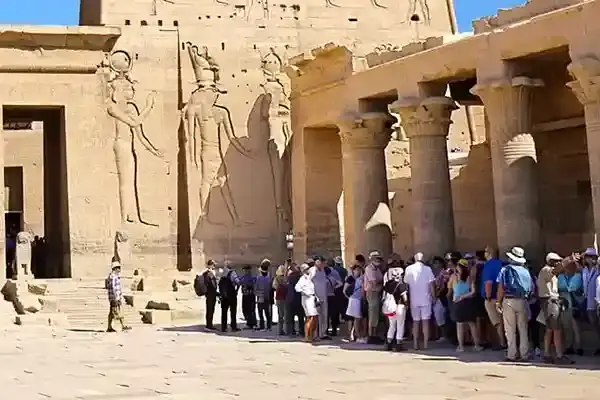The Egyptian Empire time period is one of the most astonishing times in human history. From the unification of Upper and Lower Egypt through to its decline under Roman rule it was a period of resilience and ingenuity. Along the fertile banks of the Nile, the empire flourished, which gave it the resources to develop and endow it with a lifetime. In this article, we explore the timeline, structure, and achievements of the Egyptian Empire, the story of one of humanity’s greatest civilizations.
Table of contents [Show]
- When Did the Egyptian Empire Start and End?
-
Ancient Egyptian Timeline
- 1. Early Dynastic Period (3100–2686 BCE)
- 2. Old Kingdom (2686–2181 BCE)
- 3. First Intermediate Period (2181–2055 BCE)
- 4. Middle Kingdom (2055–1650 BCE)
- 5. Second Intermediate Period (1650–1550 BCE)
- 5. New Kingdom (1550–1070 BCE)
- 6. Third Intermediate Period and Late Period (1070–332 BCE)
- 7. Ptolemaic Period (332–30 BCE)
- Egyptian Empire Time Period in Order
- How Long Did the Empire Last in Egypt?
- Why Did the Egyptian Empire Fall?
- Ancient Egypt Civilization
- Conclusion
- FAQ
When Did the Egyptian Empire Start and End?
- The Start of Ancient Egypt:
The Egyptian Empire time period started with the unity of Upper and Lower Egypt by King Narmer, or Menes, somewhere around 3100 BCE. This was a founding event of the Early Dynastic Period and the first sight of a centralized government. This was the time during which Egyptian society found its feet, including its writing system, its religion, and its administrative structures.
- The End of Ancient Egypt:
It was a gradual decline of the Egyptian Empire. From the Third Intermediate Period (1070–664 BC) there was a growing instability within the state due to internal conflict and invasion. The next period was the Late Period (664–332 BCE), during which time Egypt became a vassal state of various foreign powers, including the Assyrians and the Persians. After that, the Greek rule by the Ptolemaic Period (332–30 BCE) started after the conquest through Alexander the Great. Cleopatra VII is the last chapter of the empire when Egypt became a Roman province after her defeat by Rome in 30 BCE.
Ancient Egyptian Timeline

The timeline of Ancient Egypt is divided into several distinct periods, each contributing to the evolution of the Egyptian Empire time period:
1. Early Dynastic Period (3100–2686 BCE)
During this period centralized governance was founded, dynastic rule was established hieroglyphic writing was invented as well and the first large-scale monuments were constructed.
2. Old Kingdom (2686–2181 BCE)
This was the 'Age of the Pyramids,' when the Giza Pyramids were built and when administration was being advanced. Djoser and Khufu were pharaohs of that period who set an architectural innovation legacy.
3. First Intermediate Period (2181–2055 BCE)
The decline of centralized rule because of political fragmentation began during this period and regional governors, or nomarchs, gained autonomy, leading to internal conflict and economic challenges.
4. Middle Kingdom (2055–1650 BCE)
Egypt saw a cultural renaissance due to the reunification, with advancements in literature, art, and military strategy.
5. Second Intermediate Period (1650–1550 BCE)
The country came under invasion from the Hyksos, who brought new military technologies such as the horse-drawn chariot. It had been a period of cultural exchange and weaponizing advancements.
5. New Kingdom (1550–1070 BCE)
This was the greatest height of Egypt's power and wealth, with great territorial expansion and great architectural projects. The temples at Karnak and Luxor exemplified monumental projects of wealth and cultural achievements of the age.
6. Third Intermediate Period and Late Period (1070–332 BCE)
Foreign invasions and internal instability are featured in this phase of decline.
7. Ptolemaic Period (332–30 BCE)
After the conquest of Alexander the Great, Greek rulers dominated in the final chapter which ended with Roman annexation. At the end of an independent Egypt, Cleopatra VII reigned in the last stand of Egypt against Roman annexation.
This timeline is separated into each phase which echoes the ebbs and flows of a civilization that characterized the Egyptian Empire time period with resilience and adaptability.
— Egypt Online Tour makes booking your dream trip to Egypt easy with Egypt Tour Packages. See historic landmarks, cruise the Nile, and immerse yourself in the ever-ancient Wonders of Egypt.
Egyptian Empire Time Period in Order
The progression of the Egyptian Empire time period follows this structured order:
1- Early Dynastic Period (3100–2686 BCE): Where by the formation of Egypt as a unified state.
2- Old Kingdom (2686–2181 BCE): Characterized by the construction of iconic pyramids.
3- First Intermediate Period (2181–2055 BCE): Fragmentation and local governance took place during this period.
4- Middle Kingdom (2055–1650 BCE): An era that witnessed a cultural renaissance with centralized power restored.
5- Second Intermediate Period (1650–1550 BCE): Critical events of this period included the Hyksos invasion and cultural exchanges.
6- New Kingdom (1550–1070 BCE): There was territorial expansion and cultural flourishing during that period.
7- Third Intermediate Period (1070–664 BCE): Decentralization and invasions.
8- Late Period (664–332 BCE): These were periods of revival and Persian rule.
9- Ptolemaic Period (332–30 BCE): The last period of the Egyptian Empire time period, where the introduction of Greek culture, ended with Roman annexation.
– Let our Egypt classic tours introduce you to the wonders of ancient Egypt and walk through one of the world’s most fascinating civilizations from tombs to temples and Pyramids.
How Long Did the Empire Last in Egypt?

The Egyptian Empire time period ranged about 3,000 years, a very long period of time compared with most civilizations. King Narmer united Upper and Lower Egypt in about 3100 BCE to found the empire which continued to the death of Cleopatra VII in 30 BCE.
Several factors contributed to this longevity:
- Geographical Advantage: With fertile land and reliable resources, the Nile River was the life source of agriculture and trade.
- Strong Centralized Authority: Stable in administration, the pharaohs maintained the system strongly.
- Resilience to Challenges: Periods of turmoil never stopped Egypt from adapting, inventing, and rebuilding and from enduring for so long.
Although the empire's resilience was interrupted by some Intermediate Periods, on the whole, its ability to survive as a major power sustained for millennia.
– Egypt luxury tours redefine travel. Explore iconic sites like the Great Pyramids and Luxor’s temples while enjoying personalized service and premium experiences.
Why Did the Egyptian Empire Fall?
The decline of the Egyptian empire time period was a result of a combination of internal and external factors:
- Internal Struggles: Inefficient governance, corruption, and inner power fights progressively weakened central authority.
- Economic Challenges: The economy was overstressed by overexploitation of resources and trade disruptions. These conditions destabilized the kingdom, combined with famine resulting from irregular Nile flooding.
- Foreign Invasions: The country’s autonomy and territorial integrity were broken by successive invasions by the Hyksos, Assyrians, Persians, and Romans.
- Cultural Assimilation: The Ptolemaic rulers and later the Romans diluted traditional Egyptian culture and weakened its unique identity.
In the time of Cleopatra, Egypt had indeed lost much of its former strength. The end of the Egyptian Empire time period was completed when she was defeated by Octavian (later Augustus) and was annexed by Rome in the year 30 BCE to close a glorious chapter in human history.
– Walk through history on this 8 days Cairo, Luxor, Aswan Classic Tours. Every step has a story: from the Great Pyramids to the Temple of Philae.
Ancient Egypt Civilization

During the Egyptian Empire time periods, Egyptian civilization was unparalleled in its achievements. Being best known for monumental architecture, such as the Great Pyramids and the Sphinx, the Egyptians were also excellent at medicine, astronomy, and mathematics.
The civilization was so religious, that a pantheon of gods was present in every aspect of life and government. The Pharaohs were considered divine rulers, being literally the bridge between mortal and spiritual realms. The belief in the afterlife inspired advancements in mummification and too many elaborate tombs.
Egyptian society was classed hierarchically, with the pharaoh heading the pack, followed by nobles, priests, scribes, artisans, and farmers. Such stratification was efficient in administration and in specialization, long enough to sustain the empire.
There are many ways to say it but Ancient Egypt during the Egyptian Empire time period is a testament to human ingenuity, and one of its most remarkable examples is left in such fields of artistic expression, architecture, and governance.
– Explore the Egyptian beauty on this 5 days Cairo to Luxor tour package. Explore Egypt's storied past seeing the Pyramids, Sphinx, Karnak Temple, and more.
Conclusion
Human achievement, resilience, and creativity at its best can be found in the Egyptian Empire time period. During its lasting Empire of 3,000 years, Ancient Egypt shaped the cultural, architectural, and scientific legacy of the ancient world. The rise, the peak, and the decline of that empire provide invaluable lessons in the art of governance, adaptation, and innovation which have made it one of history’s most remarkable civilizations.
FAQ
1- Is ancient Egypt 7000 years old?
Human settlements in Egypt go back some 7,000 years, but the Egyptian empire began only some 3100 BCE, which makes the recorded civilization about 5,000 years old.
2- What killed the Egyptian empire?
Weakened governance, economic struggles, and invasions by Hyksos, Assyrians, and Romans all contributed to the empire’s decline, ending with the defeat of Cleopatra VII in 30 BCE and Roman annexation.
Popular Categories
Related properties
Cairo, Aswan, and Luxor
-
Precio
$ 2,850
-
Tipo
Package
Cairo, Aswan, and Luxor
-
Precio
$ 1,850
-
Tipo
Package











